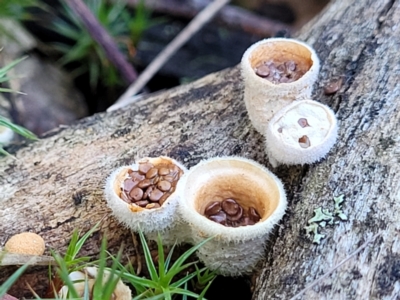Disk-like to cup-like
The feature common to the fungi in this group is the disk-like to cup-like component of the fruitbody. They are divided into the following sub-groups (and you will find more about them in the respective sub-group overviews.):
1... The fruitbody consist of a cup (from a couple of millimetres to a centimetre or so in diameter) within which you initially find one or more ‘eggs’. Over time the eggs are ejected. Most of these ‘egg’ fungi belong to what are known colloquially as Birds nest fungi (the odd one out being the Cannonball fungus).
2... The fruitbody never has any ‘eggs’. The disk-like to cup-like structure may sit atop a stem or be stemless and the disks/cups range from under a millimetre to 10 or so centimetres in diameter.
Warning
If you have a leathery, downward facing cup on wood, check Stereum (in https://canberra.naturemapr.org/Community/Categories/Guide/1717) - especially if the outer surface of the cup is furry or hairy.
Announcements
There are currently no announcements.
Discussion
Ascocoryne sarcoides
zz – ascomycetes - apothecial
zz – ascomycetes - apothecial
zz – ascomycetes - apothecial
Top contributors
- trevorpreston 65
- Teresa 50
- TimL 46
- KenT 34
- Heino1 31
- CathB 17
- Hejor1 11
- Bushrevival 10
- RobG1 8
- LisaH 6
Top moderators
- Heino1 174
- Teresa 56
- Heinol 54
- MichaelMulvaney 40
- Heino 28
- KenT 19
- Csteele4 11
- Pam 6
- CanberraFungiGroup 3
- JTran 3









